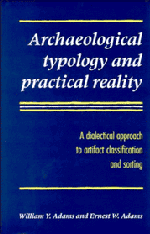 Archaeological Typology and Practical Reality
Archaeological Typology and Practical Reality Book contents
- Frontmatter
- Contents
- List of figures
- List of tables
- The archaeologist's preface
- The philosopher's preface
- PART I Introductory
- PART II The nature of types and typologies
- PART III Typology in action: the Medieval Nubian Pottery Typology
- 9 Origin and development of the Nubian Typology
- 10 Basic features of the Nubian Typology
- 11 The uses of the Nubian Typology
- 12 Philosophical implications
- PART IV Pragmatics of archaeological typology
- PART V Classification, explanation, and theory
- Appendices
- References
- Index
12 - Philosophical implications
Published online by Cambridge University Press: 23 November 2009
- Frontmatter
- Contents
- List of figures
- List of tables
- The archaeologist's preface
- The philosopher's preface
- PART I Introductory
- PART II The nature of types and typologies
- PART III Typology in action: the Medieval Nubian Pottery Typology
- 9 Origin and development of the Nubian Typology
- 10 Basic features of the Nubian Typology
- 11 The uses of the Nubian Typology
- 12 Philosophical implications
- PART IV Pragmatics of archaeological typology
- PART V Classification, explanation, and theory
- Appendices
- References
- Index
Summary
We will now consider some corollaries of the philosophy of conceptual instrumentalism that was outlined in Chapter 1. To begin with, it involves a wholly pragmatic view of the role that definitions play in scientific typologies. This in turn has implications for more general philosophical issues, and in particular for the presently much-debated question of whether types are “real.” We will end the chapter by commenting briefly on that issue, and also on certain similarities and differences between typologies and systems of measurement. Here as elsewhere our philosophical comments must be fairly brief, and cannot fully explore the issues that we raise, much less resolve them. Our main concern is to show the interconnection between our views on archaeological typology, and on more general philosophical problems.
Definiteness and definitions
The philosophy of conceptual instrumentalism that was set forth in Chapter 1 holds that typologies and other systems of deliberately constructed concepts in the sciences are instruments that are designed for specific purposes, and they are to be evaluated in terms of their effectiveness in serving those purposes. It is implicit in this philosophy that definiteness in the concepts is not an end in itself, and should only be insisted upon to the extent that it serves the purposes for which the instrument was created. This holds true of any feature in a typology that can vary in definiteness, including type concepts, and the types themselves.
- Type
- Chapter
- Information
- Archaeological Typology and Practical RealityA Dialectical Approach to Artifact Classification and Sorting, pp. 143 - 154Publisher: Cambridge University PressPrint publication year: 1991


